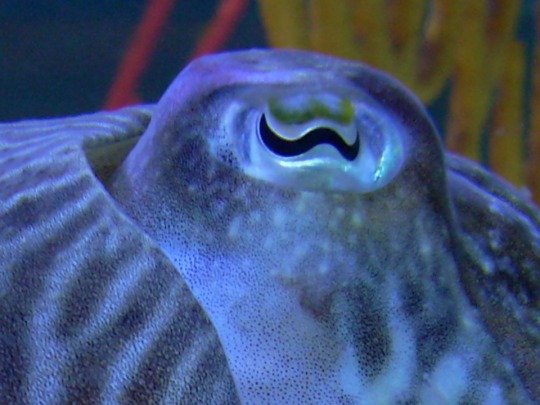
The eyes of cephalopods like octopus, squid, and cuttlefish possess only one kind of photoreceptor, implying that they are colorblind, being able to see only in greyscale. But wait! They are famous masters of camouflage, being able to blend with their surroundings, and they signal each other in intricate color patterns. These feats suggest that they are not colorblind.
Two main hypotheses to explain this mystery are (1) they also see with their skin (Wardill et al. 2015) or (2) they make use of chromatic aberration (Stubbs & Stubbs 2016).
Cephalopods certainly do possess photosensitive molecules called opsins in their skin, so potential exists for cephalopods to detect light with their skin. However, the photosensitive molecules in the skin are like those in the eyes, so it’s not clear how that would help them see color any better than the eyes do.
Chromatic aberration is the differential bending of light of different wavelengths (colors). That’s how a prism splits white light, and why when your eyes get dilated by the eye doctor, besides things becoming blurry, you also see rainbows around things. Light of different wavelengths passing through a lens has different focal points. For most organisms and for human-made optical devices, chromatic aberration is a problem to be minimized.
The chromatic aberration hypothesis proposes that instead of avoiding chromatic aberration, cephalopods enhance it using their peculiar off-axis pupil shapes. This enhancement allows them to detect color by monitoring image blurring as focus changes. Computer models show that this method of image detection is possible.
Such use of chromatic aberration could explain why cephalopods have such bizarre pupil shapes. The pupil in some octopuses is an elongate slit, and in cuttlefish, it is the shape of a W.
These two hypotheses yield different predictions under certain circumstances, such as colors on a flat field (for which focus would not change). Now we await results of experiments testing between these two possibilities. Then we will have an answer for how cephalopods can see color, despite having the appearance of being color blind. We might need to re-evaluate other creatures that have been labeled colorblind.
Timothy A. Pearce is Curator of Collections, Section of Mollusks at Carnegie Museum of Natural History. Museum employees are encouraged to blog about their unique experiences and knowledge gained from working at the museum.
Literature cited
Kingston, A.C.N., Wardill, T.J., Hanlon, R.T. & Cronin, T.W. 2015. An unexpected diversity of photoreceptor classes in the longfin squid, Doryteuthis pealeii. PLoS ONE 10(9): e0135381. doi.org/10.1371/journal.pone.0135381
Stubbs, A.L. & Stubbs, C.W. 2016. Spectral discrimination in color blind animals via chromatic aberration and pupil shape. Proceedings of the National Academy of Science U.S.A.113: 8206–8211. doi: 10.1073/pnas.1524578113
